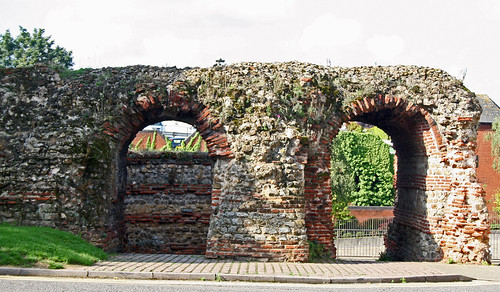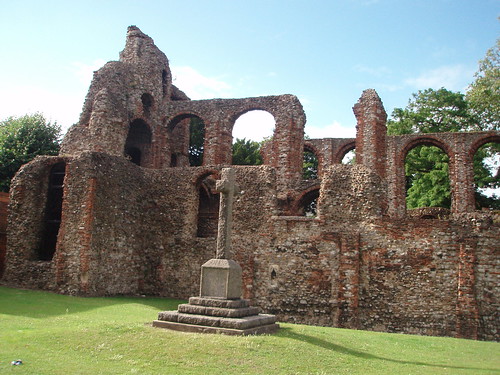Colchester can lay claim to a bevy of titles: some impressive, some not so. For instance, you might not know that it’s the first-ever town in Britain, founded as a Roman soldiers’ outpost shortly after Claudius‘ 43AD landing. You may also be unaware that it’s the home of Mary Whitehouse, Colchester United and Darren Day. A mixed bag, admittedly.
But there’s no denying Colchester’s history runs deep, and the wealth of ancient history lurking above ground could put central London to shame. Walls, churches, castles and priories are the lasting evidence of a town which became the capital of England in its Roman infancy, before the brutality of Boudicca and her marauding Celts saw to its total destruction in 60AD. Later years saw the city rebuilt by the Romans, before Saxons and Normans stamped their fearsome mark upon it.
Colchester, ne Camulodunon (a Celtic name meaning ‘fortress of the war god Camulos’), was near the summit of our Ancient World in London video hitlist, being just 55 miles from London in Essex. And thankfully we had the perfect guide: Howard Brooks, of the Colchester Archaeological Trust. The trust have been discovering and preserving the city’s history for decades. And it’s clear that Howard has lost none of his passion for archaeology. “It’s a thrill to be a digger working on a site as rich as this in Colchester,” he says.
Our first stop lies predictably on the outskirts of central Colchester, where the Roman wall (Check out our Top Ten Roman Walls)is a poignant reminder of Boudicca’s bloodthirsty rampage. Built just after her revolt in 60AD, it’s still visible in giant chunks today. The Balkerne Gate is a triumphant arch and watchtower at the mouth of the ancient city. “This is where the guards who would have been stationed in theory to say ‘Halt! Who goes there?'” says Howard. Most of the gate still stands, including lumps of Roman waterproof mortar, which allowed them to build in the less-than-tropical climates of East Anglia.
There’s a lot more of Colchester’s Roman wall left than in London, a large part of which we visited last week with Ian Smith(Watch that video). This may be because Colchester was the first city to feel the wrath of the Boudiccan Revolt, an incredible piece of British history. Boudicca, an Iceni queen native to modern Norfolk, was betrayed by the Roman British governer, beaten and her daughters raped. Understandably enraged, Boudicca rounded up her Celtic men and marched on Colchester, London and StAlbans in 60AD, burning each city to the ground and killing up to 80,000 people in the process. To this day, a layer of burned soil in each city is testament to the ubiquity of her destruction.
Boudicca would eventually meet a mysterious end a year later, defeated by the Roman governer at the Battle of Watling Street, whereabouts unknown, and slain in battle or by her own hand, depending on who you believe. Colchester, or what was left of it, was rebuilt, and the walls duly went up to avoid a bloody repeat. Colchester would then play second fiddle to London for its entire history, losing capital status but remaining an important outpost.
The Roman assimilation of Britain continued at break-neck speed until the 4th century AD. And the empire’s progressiveness is shown in Colchester’s Roman church, oddly found at the foot of a modern roundabout. “It’s almost 300 years after the Roman invasion we became officially Christianised,” says Howard. Before Constantine led the empire’s conversion in 313, Britain was still worshipping pagan gods like Mithras (see his temple in London here) and the Roman emperor, who was also officially a god.
Later centuries saw the Saxons bringing their versions of Christianity to the country, and Holy Trinity Church in Colchester’s city centre shows perfectly the ramshackle nature of Saxon architecture. “It’s been built out of Roman material, stone, brick and tile that has been recycled from the Roman houses around here,” says Howard.
Our next stop is the Roman theatre, discovered in the 1980s, lying strangely inside a house in Colchester’s Dutch Quarter. This is “where they had gladiatorial contests and also probably addresses of the council and meetings,” says Howard. Its current home, inside a small house in the city’s Dutch quarter, only adds to its mystique.
Howard takes us round St Botolph’s Priory, Britain’s first such Augustinian priory, and Colchester Castle, the largest-ever Norman keep, before telling us about Colchester’s hottest story: the Roman circus. Discovered in 2005, it’s Britain’s only chariot-racing track, and the biggest outside Rome.
The trust is understandably excited – especially now a fundraiser to save the site from development has just reached its 200,000 target (see the full story here). “It’s like Ben Hur, it’s a place where the Romans raced chariots competitively round a long circuit,” says Howard. The trust hopes to preserve the circus as an interactive centre where you can see chariots racing on a big screen. We leave Colchester praying they can make it happen.
HD Video: Colchester/Camulodunon (Save Our Roman Circus)
(Click here to read a transcript of this video)
You can participate in Ancient World in London through our contests – check out our latest blogger’s challenge on London’s most important site, and you can join in the fun with our virtual quest as well as have a look back at our recent lecture with astronomy author Paul Murdin. Take a look through our soon – with your help – to be complete directory of The Ancient World in London and suggest any that we may have missed. Just as well, do not hesitate to contact us if you have any suggestions for our webseries! Keep up-to-date with everything in the Ancient World in London by subscribing to our RSS feeds, or by following us onTwitter,YouTube,Facebook,FlickrandiTunes.Heritage Key – Unlock the Wonders.

